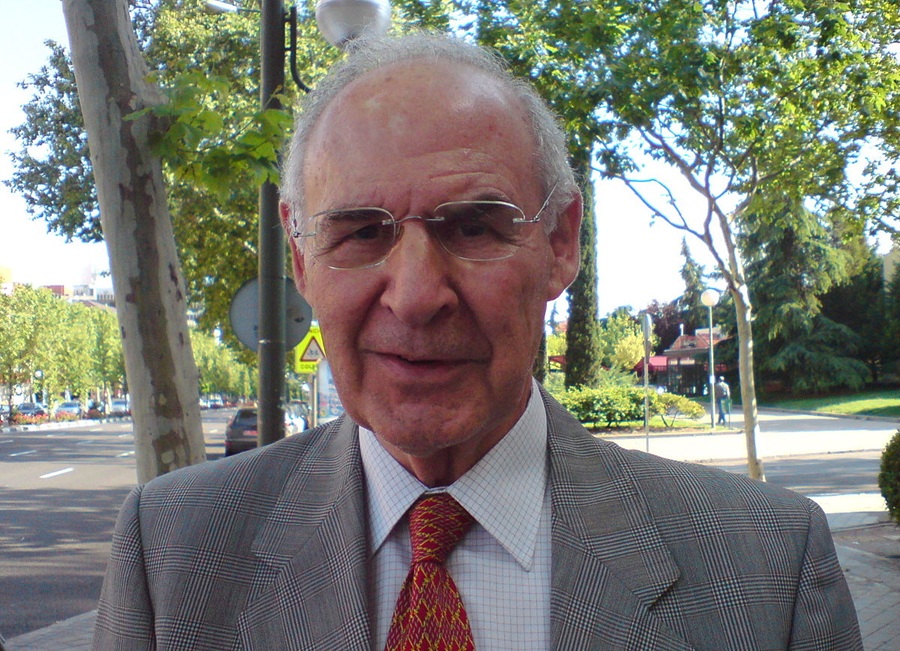- Science
- 3 de October de 2025
- No Comment
- 6 minutes read
Emiliano Aguirre, a centenary of light and fossils

Emiliano Aguirre Enríquez in June 2007. / Wikipedia
In an age of denialism, pedagogical dogmas and pseudosciences, his legacy feels more relevant than ever
When Emiliano Aguirre was born in Ferrol in 1925, palaeontology in Spain was barely more than an incipient discipline, confined to natural history cabinets and cut off from wider society. A century later, in 2025, the name of Dr Aguirre resounds in classrooms, museums and excavations as a symbol of rigour, commitment and a passion for the deep traces of time. This centenary honours not only the scientist but also the teacher, the humanist and—why not say it—the creator of an evolutionary consciousness in Spain. A Darwin in a cassock, who laid aside his habit to embrace the scientific method without losing his soul.
Aguirre was never just an academic. His life, in fact, was as stratigraphic as the sediments he studied. He entered the Compañía de Jesús in his youth and pursued Humanities, Philosophy and Natural Sciences. Yet beyond dogma there soon emerged a deeper calling: to understand the human being from biological roots rather than doctrinal assumptions. As if stung by a trilobite, he left the clergy and immersed himself in geology and palaeontology, largely self-taught but strengthened by studies in Madrid and Paris. That shift from pulpit to laboratory was not simply biographical; it embodied the transition from a Spain bound by religious thought to one seeking its place on the international scientific map.
It was in the 1970s that Aguirre wrote his most decisive chapter: Atapuerca. Long before the names Sima de los Huesos or Homo antecessor entered school textbooks, he had sensed that the Burgos site held a crucial key to our evolution. In 1976 he led the first systematic excavations in the Trinchera del Ferrocarril. He seemed convinced that what lay there was not only evidence of the genus Homo, but also an opportunity for Spain to take its place in global palaeoanthropology.
Yet more than any discovery, Aguirre’s true achievement was to establish a methodology and an ethic of scientific work. He brought together geologists, biologists, archaeologists and anthropologists into a genuinely multidisciplinary team, at a time when the word was little more than bureaucratic jargon. He also knew when to pass the baton, never clinging to personal protagonism. In an era of inflated egos, his humility made him all the greater. His teaching style was equally distinctive: slow, deliberate, as if each word had to find its precise stratum before being laid down. He cared little for quick answers; what mattered were questions well posed. And he had a rare gift for linking human evolution with the history of ideas, with ethics, with literature. It was not unusual, in the middle of a lecture on Neanderthal skulls, for him to turn to Cervantes, Teilhard de Chardin or the Second Law of Thermodynamics. Far from distracting, such digressions illuminated, especially when, faced with a fossil unearthed by one of his students, he would remark: “There’s a thesis here”.
What made Aguirre singular was that he was a builder of fossils—not only bones, but ideas that gave them renewed meaning. Unlike those palaeontologists who confined themselves to classification, he sought the narrative that bound the pieces together. He reconstructed not only skeletons, but also the stories of who we were, how we became human, and what that means in a society where palaeoanthropology is often overshadowed by market immediacy, media frivolity or professional prejudice.
His centenary should not be reduced to official ceremonies or commemorative plaques. It deserves critical re-readings, new editions of his work, documentaries on his life, and above all, a reflection on the role of scientific culture in our education and society. For Aguirre’s deepest conviction was that scientific education is the foundation of a knowledgeable, free and critical citizenry. In an age of denialism, pedagogical dogmas and pseudosciences, his legacy feels more relevant than ever.
To speak of Emiliano Aguirre today is also to speak of hope—of an interdisciplinary, profound and humble knowledge that stands against the arrogance of those who, out of prejudice or self-interest, proclaim themselves experts in education or science. Fossils do not only speak of our biological past; they also point to our human future.
A hundred years after his birth, Aguirre’s figure remains as alive as the questions he taught us to ask. For the best way to celebrate a centenary is not to look back, but to move forward with eyes wide open. Should we fail to do so as he did, we shall remain trapped in the prejudices and interests of the self-serving.
___
Leandro Sequeiros: “Here’s a thesis” (Emiliano Aguirre dixit)
Source: educational EVIDENCE
Rights: Creative Commons


